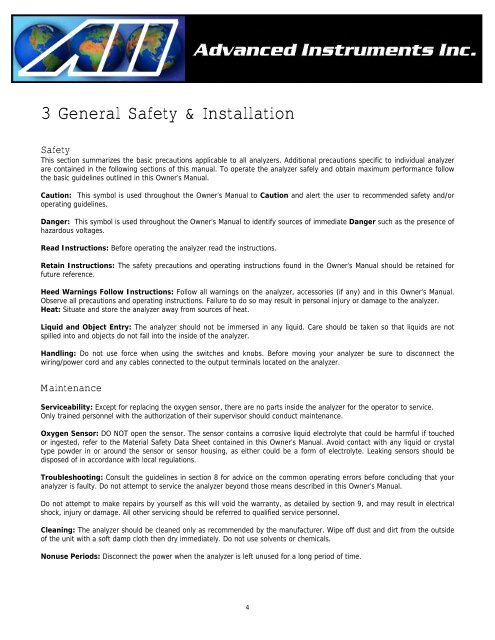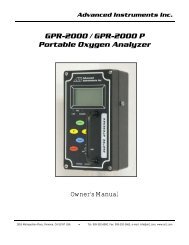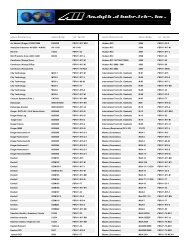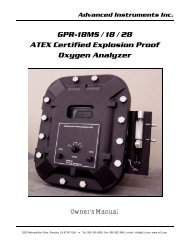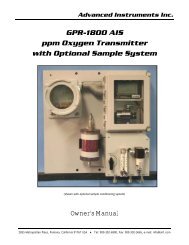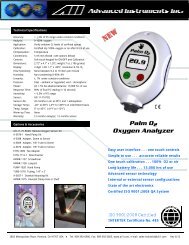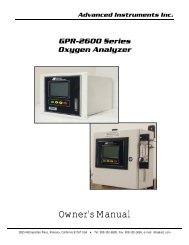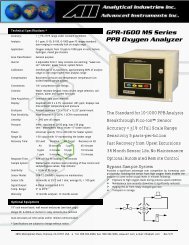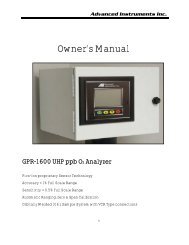GPR-1200 Portable ppm Oxygen Analyzer - Advanced Instruments Inc.
GPR-1200 Portable ppm Oxygen Analyzer - Advanced Instruments Inc.
GPR-1200 Portable ppm Oxygen Analyzer - Advanced Instruments Inc.
Create successful ePaper yourself
Turn your PDF publications into a flip-book with our unique Google optimized e-Paper software.
3 General Safety & InstallationSafetyThis section summarizes the basic precautions applicable to all analyzers. Additional precautions specific to individual analyzerare contained in the following sections of this manual. To operate the analyzer safely and obtain maximum performance followthe basic guidelines outlined in this Owner’s Manual.Caution: This symbol is used throughout the Owner’s Manual to Caution and alert the user to recommended safety and/oroperating guidelines.Danger: This symbol is used throughout the Owner’s Manual to identify sources of immediate Danger such as the presence ofhazardous voltages.Read Instructions: Before operating the analyzer read the instructions.Retain Instructions: The safety precautions and operating instructions found in the Owner’s Manual should be retained forfuture reference.Heed Warnings Follow Instructions: Follow all warnings on the analyzer, accessories (if any) and in this Owner’s Manual.Observe all precautions and operating instructions. Failure to do so may result in personal injury or damage to the analyzer.Heat: Situate and store the analyzer away from sources of heat.Liquid and Object Entry: The analyzer should not be immersed in any liquid. Care should be taken so that liquids are notspilled into and objects do not fall into the inside of the analyzer.Handling: Do not use force when using the switches and knobs. Before moving your analyzer be sure to disconnect thewiring/power cord and any cables connected to the output terminals located on the analyzer.MaintenanceServiceability: Except for replacing the oxygen sensor, there are no parts inside the analyzer for the operator to service.Only trained personnel with the authorization of their supervisor should conduct maintenance.<strong>Oxygen</strong> Sensor: DO NOT open the sensor. The sensor contains a corrosive liquid electrolyte that could be harmful if touchedor ingested, refer to the Material Safety Data Sheet contained in this Owner’s Manual. Avoid contact with any liquid or crystaltype powder in or around the sensor or sensor housing, as either could be a form of electrolyte. Leaking sensors should bedisposed of in accordance with local regulations.Troubleshooting: Consult the guidelines in section 8 for advice on the common operating errors before concluding that youranalyzer is faulty. Do not attempt to service the analyzer beyond those means described in this Owner’s Manual.Do not attempt to make repairs by yourself as this will void the warranty, as detailed by section 9, and may result in electricalshock, injury or damage. All other servicing should be referred to qualified service personnel.Cleaning: The analyzer should be cleaned only as recommended by the manufacturer. Wipe off dust and dirt from the outsideof the unit with a soft damp cloth then dry immediately. Do not use solvents or chemicals.Nonuse Periods: Disconnect the power when the analyzer is left unused for a long period of time.4


